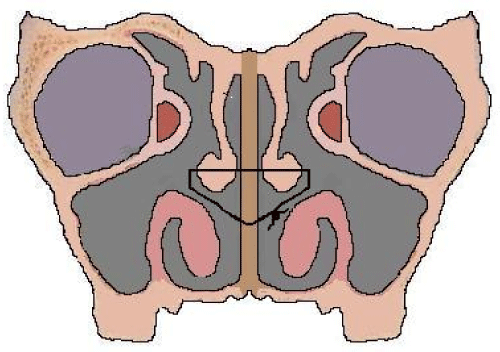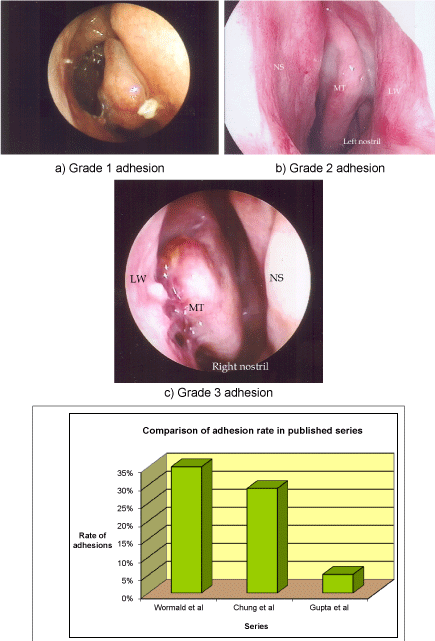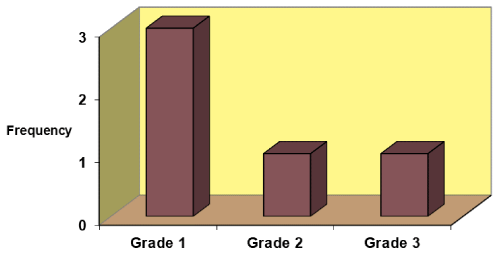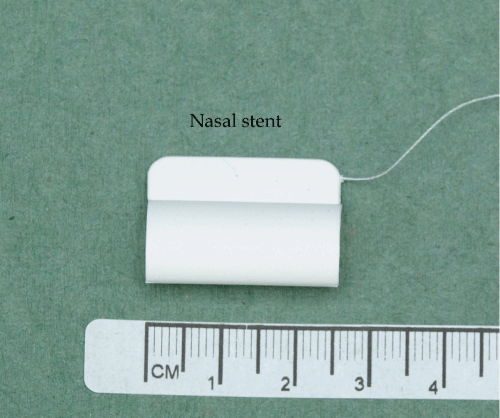To study the results of trans-septal suture technique in medializing and stabilizing the middle turbinate after endoscopic sinus surgery.
Prospective study of 50 consecutive patients who underwent Endoscopic Sinus Surgery by the same surgeon.
All the patients undergoing Endoscopic sinus surgery by the same surgeon who were willing to take part in the study were enrolled. Patients who underwent at least ethmoidectomy were selected for the study. A Transeptal suture was used to medialize and stabilize the middle turbinate after the operation.
We had a adhesion rate of 5.15% with this method of stabilizing the middle turbinate after the sinus surgery. These adhesions were mostly due to adhesion of the tip of middle turbinate to the lateral wall of the nose.
It is safe and easy technique to ensure medialization and stabilization of the middle turbinate after the sinus surgery. The suture is absorbable and doesn't cause any long-term mucosal changes during the healing of the sinuses. Nearly all the patient reported an improvement in the smelling sense after the operation.
Endoscopic sinus surgery, Middle turbinate, Trans-septal suture
Over the years the importance of middle turbinate has increased with the wider use of nasal endoscopes in the management of the sino nasal diseases. Lateralization of the middle turbinate may cause scarring & adhesions which may affect the results of the surgery. We have been using a simple technique of placing a transeptal suture to stabilise the middle turbinate and prevent adhesions between middle turbinate and the lateral wall of the nose. We have used this technique in prospective study, which is described here.
Nasal Endoscope, 4/0 vicryl suture on 13 mm straight needle.
The study was planned as a prospective study in the Department of ENT at The Great Western Hospital, Swindon & Marlborough NHS Trust.
Patients were assessed by a thorough history and clinical examination. A score of the loss of smell was taken on a visual analogue score of 1-10 before the operation and after the operation. A preoperative CT scan was also requested.
Patients undergoing endoscopic sinus surgery involving at least middle meatal antrostomy, anterior and posterior ethmoidectomy done by the same surgeon.
A simple method of putting a transeptal suture, which results in medialization of middle turbinate and prevent adhesions and scarring between lateral wall and the turbinate (Figure 1).
 Figure 1: Schematic representation of the technique of Transeptal suture.
View Figure 1
Figure 1: Schematic representation of the technique of Transeptal suture.
View Figure 1
Patients were followed at 3 weeks and 6 weeks.
Postoperative medialization and stabilization of middle turbinate as assessed by the presence or absence of adhesions.
Patients were asked to mark on a visual analogue score from 1-10 regarding the ability to smell after the operation and the results were compared with preoperative status.
Out of a total of 50 patients, 47 underwent bilateral and 3 had unilateral endoscopic sinus surgery i.e. (47 × 2) + 3 = Endoscopic sinus surgery on 97 sides.
There were a total of 4 patients with adhesions, of which only one had bilateral adhesions i.e. 3 + 2 = 5 adhesions with a rate of 5.15%.
A visual analogue score for the ability to smell was used to assess the patients olfactory status. Among the patients who were recruited for the study most patient's score was between 2-3 before the operation. After the operation the score improved to 7-8 on average.
The handling of the middle turbinate is very important as undue damage to the delicate mucosa may result in adhesions, which may alter the postoperative results. Some surgeons in the past have advocated partial or complete resection of the middle turbinate to prevent adhesions. The middle turbinate acts as an important landmark in the anatomy of the Paranasal sinuses. Its presence may prevent inadvertent damage to the base of the skull. Medialization of the middle turbinate is vital to prevent adhesions, which may cause obstruction of the opened ethmoids. Although the best way to avoid adhesions and synchiae is to minimize damage to the delicate mucosa, at times a polypoidal middle turbinate may restrict the passage of the nasal endoscope and prevent good view of the disease in the ostiomeatal complex. And therefore some debridement of the middle turbinate may be necessary in order to access the ostiomeatal complex.
Over the years various techniques to ensure the medialization of middle turbinate have been in practice [1-3]. These may sometimes cause foreign body reaction with resultant granulation tissue causing poor results. W Bolger described the creation of an adhesion between the medial aspect of the MT and the nasal septum by abrading these surfaces using a sickle knife [4]. However for "Bolgerization" to work a middle meatus stent has to be used to approximate the raw surfaces for the natural healing process to occur to result in an adhesion between medial surface of the middle turbinate and the septum. Freidman, et al. followed the same principle but using a microdebrider to create a raw surface [5]. Mourkarzel, et al. used surgical clips between middle turbinate and the septum [6]. These may cause discomfort and bleeding at the time of removal. Jacobson and Kasworm reported an incidence of Toxic Shock Syndrome after nasal surgery in cases where postoperative packing or stents were used [7]. This technique of putting a transeptal suture to stabilize the middle turbinate was first described in 1996 in a retrospective chart review of 31 patients [8]. For the reasons not known this useful technique is not widely used as it is considered to be technically difficult and time consuming.
Various factors such as inflammatory lesions, pneumatized middle turbinate, improper surgery or inadequate follow may be responsible for adhesions in the postopeartive period [9].
Lateralization of the middle turbinate, which may cause postoperative adhesions, is a common cause for the failures of endoscopic sinus surgery.
Jameson M, et al. used Floseal (FS) on bleeding and synechiae formation and commented that it may cause less postoperative bleeding but does not cause less scarring or medialization of the middle turbinate [10]. Wormald, et al. found the rate of adhesions after merogel packing as 35% versus 22.5% in the controlled side (no packing) [11]. In a separate study Chung, et al. used Mitomycin C for the prevention of adhesions formation after endoscopic sinus surgery. They found the postoperative adhesion rate to be 29% with 10.9% in bilateral and 18% in unilateral cases. They found adhesion in 3.6% of patient treated with local mitomycin c versus 14.5% in control treated with saline soaked packs (control) [12].
Miller, et al. on the other hand found no statistical difference in synchia formation between merogel and nonabsorbable merocel [13].
The transeptal suture is absorbable and avoids any long-term foreign body reaction. It avoids excessive granulation tissue as found with clips. It is more definitive and doesn't depend on healing of raw surfaces between the turbinate and the septum. We have found the transeptal suture technique to be a good way of ensuring good postoperative results.
The benefits of adequate medialization of the middle turbinate may be:
• It offers good view to the ostiomeatal complex during postoperative period
• It is easier to remove crusts and inspection of the ethmoid complex
• The steroids drops or sprays can adequately reach the opened ethmoids cells
• Aeration of the opened ethmoids is better as the middle turbinate doesn't get lateralized and block the OMC. Adequate aeration is vital to the healing of the diseased nasal mucosa
Based on the type of adhesions seen in the postoperative period, we have devised a grading of the adhesions between the lateral surface of the middle turbinate and the lateral wall of the nose.
Grade 1: Adhesion involving anteroinferior edge of the middle turbinate and the lateral wall of the nose with good access to the opened ethmoid cavity.
Grade 2: Adhesion involving middle part of the middle turbinate with partial access to the opened ethmoid cavity.
Grade 3 : Gross adhesion with no access to the opened ethmoid cavity (Figure 1, Figure 2, Figure 3, Figure 4 and Figure 5).
 Figure 2: a) Grade 1 adhesion; b) Grade 2 adhesion; c) Grade 3 adhesion; d) A comparison of our study with previous quoted rates.
View Figure 2
Figure 2: a) Grade 1 adhesion; b) Grade 2 adhesion; c) Grade 3 adhesion; d) A comparison of our study with previous quoted rates.
View Figure 2
 Figure 3: The frequency of the adhesions is shown as a graph.
View Figure 3
Figure 3: The frequency of the adhesions is shown as a graph.
View Figure 3
 Figure 4: Various ways to medialize the MT.
View Figure 4
Figure 4: Various ways to medialize the MT.
View Figure 4
 Figure 5: a) Nasl Stent; b) Merocel pack used to medialize the MT; c) Steel Clip used to medialize the MT. [Legends used: S- septum; MT- middle turbinate; N-needle; E-ethmoids; K-knot]; d) Well medialize MT with open access to ethmoid cavity; e) Well healed sinus opening.
View Figure 5
Figure 5: a) Nasl Stent; b) Merocel pack used to medialize the MT; c) Steel Clip used to medialize the MT. [Legends used: S- septum; MT- middle turbinate; N-needle; E-ethmoids; K-knot]; d) Well medialize MT with open access to ethmoid cavity; e) Well healed sinus opening.
View Figure 5
Although previously described the middle turbinate transeptal suture technique is not widely used, at least partly because of the feeling that it is difficult to learn. Post Endoscopic sinus surgery middle turbinate adhesions are thought to be the single largest cause of surgical failure. The rate of these adhesions is said to be 5-40% if no care is taken to prevent these cause of surgical failures. The senior author has been using this technique regularly over last 4 years with only 1-2% adhesions rate. Those failures were mostly due to adhesion of the tip of middle turbinate to the lateral wall of the nose. The current study is a prospective study of 50 patients in whom this technique was used to stabilize and medialize the middle turbinate.
We feel the transeptal middle turbinate suturing provides the simplest, efficient and most patient friendly technique of preventing adhesions after endoscopic sinus surgery.